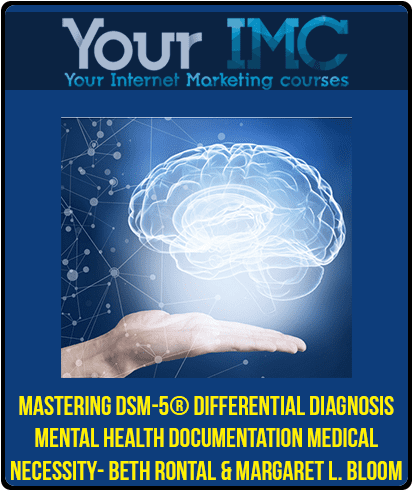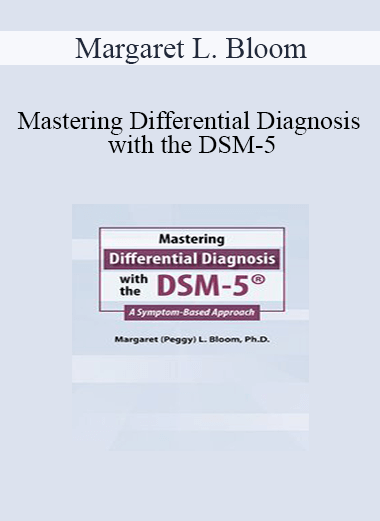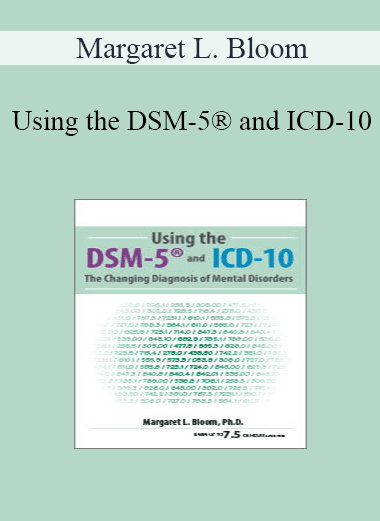[Download Now] Mastering Differential Diagnosis with the DSM-5: A Symptom-Based Approach – Margaret L. Bloom
$219.00 Original price was: $219.00.$66.00Current price is: $66.00.
[Download Now] Mastering Differential Diagnosis with the DSM-5: A Symptom-Based Approach – Margaret L. Bloom
Product Delivery: You will receive a download link via your order email immediately
Should you have any question, do not hesitate to contact us: [email protected]
[Download Now] Mastering Differential Diagnosis with the DSM-5: A Symptom-Based Approach – Margaret L. Bloom
Salepage_https://catalog.pesi.com/item/77802/
Archive: https://archive.fo/wip/PpEZX
Take your DSM-5® diagnostic skills to the next level! This advanced recording is designed specifically for mental health professionals seeking to master clinical diagnosis and differential diagnosis using the DSM-5®, ICD-10 and online assessment tools. The focus of this workshop is on the key symptoms for each diagnosis, common differential diagnoses and frequent comorbid disorders of anxiety, depressive, trauma-related, substance-related, psychotic and neurodevelopmental disorders. Case examples and studies are provided throughout – giving you the opportunity to learn and apply a four-step symptoms-based diagnostic method. Topics include the clinical intake interview, differential diagnoses, online assessment tools to narrow diagnosis and potential comorbidities.
- Apply a four-step diagnostic process to accurately identify and code a client’s diagnosis.
- Specify key symptoms and diagnostic criteria for frequently diagnosed mental disorders.
- Determine important differential diagnoses for anxiety, depressive, trauma-related, substance-related, and neurodevelopmental disorders.
- Analyze differential diagnoses for children who present with disruptive behavior.
- Differentiate between overlapping symptoms and comorbid conditions in order to provide the correct diagnosis.
- Utilize the DSM-5® severity tables, assessment tools, and coding notes to improve the accuracy of diagnosis and ICD-10 coding.
Quick Review of Using the DSM-5 and ICD-10
- Diagnosis of mental disorders in the U.S.A.
- Use of two models DSM-5 and ICD-10
- Use of Specifiers
- DSM-5 and ICD Coding and Recording
- Web-based DSM-5 Resources
- Digital Updates
- DSM-5 Cross-Cutting Symptom Measures and Screening Tools
Four Step Diagnostic Method
- Case 1: Michelle
- Goals of the Clinical Interview
- Steps to a DSM-5 Diagnosis
- Step 1: Gathering Client Information and Behavior Sample
- Interview Phases I, II, and III
- Using Client Observation Sheet in Step 1
- Using assessment tools to supplement data
- Sources of Error to avoid in the clinical interview
- Step 2: Identifying Key DSM-5 Symptom Clusters
- Step 3: Differential Diagnosis List
- Considering medical and substance causes of symptoms
- Assessments for Alcohol, Drug and Tobacco use
- Differential Diagnosis Guides in DSM-5 Manual
- Step 4: Initial DSM-5 Diagnosis
- Comorbidity considerations
Differential Diagnosis of Specific DSM-5 Mental Disorders
Clients with Symptoms of Depression
- Key symptoms of Depression and Dysphoria
- Substance-Related and Medical conditions with Depressive Symptoms
- Mental Disorders with Symptoms of Depression
- Diagnosis Challenge: Case 2: Marilyn Wilson
- Differentiating Disorders with Symptoms of Depression
- Frequent Comorbid Disorders
Clients with Fear and Anxiety
- Key Symptom Patterns of Anxiety
- Substance-Related and Medical conditions with Anxiety Symptoms
- Mental Disorders with Symptoms of Anxiety
- Differentiating by Patterns of Anxiety symptoms
- Diagnosis Challenge: Case 3: Hunter
- Specific Differential Diagnoses
- Generalized Anxiety Disorder
- Panic Disorder
- Frequent Comorbid Disorders
Clients with Abnormal or Impaired Cognition
- Diagnostic Challenge: Case 4: Christa
- Sorting Patterns of Psychosis
- Substance-Related and Medical conditions with Psychosis symptoms
- DSM-5 mental disorders with psychosis symptoms
- Sorting Patterns of Cognitive Deficit: Case 5: Bob Gray
- Substance-Related and Medical conditions that produce cognitive deficits
- Differential Diagnosis when Cognitive Deficits as a Key Symptom
- Neurodevelopmental Disorders
- Neurocognitive Disorders
Clients with Repetitive Thoughts and Behaviors
- Diagnostic Challenge: Case 6: Devin
- Mental Disorders with Symptoms of Repetitive Thoughts and Behaviors
- Substance-Related and Medical conditions associated with Repetitive Thoughts and Behaviors
- Frequent Comorbid Disorders
Clients with Disruptive Behaviors
- Disruptive Behavior Symptoms
- Diagnostic Challenge: Case 7: Natalia is a Problem
- Substance-Related and Medical conditions associated with Disruptive Behaviors
- Differential Diagnosis by Patterns of Disruptive Behavior
- Defiant, Angry and Vindictive
- Impulsive and/or Antisocial
- Comorbidity in DSM-5 Disruptive, Impulse Control, and Conduct Disorders
Tag: Mastering Differential Diagnosis with the DSM-5: A Symptom-Based Approach – Margaret L. Bloom Review. Mastering Differential Diagnosis with the DSM-5: A Symptom-Based Approach – Margaret L. Bloom download. Mastering Differential Diagnosis with the DSM-5: A Symptom-Based Approach – Margaret L. Bloom discount.
Delivery Method
– After your purchase, you’ll see a View your orders link which goes to the Downloads page. Here, you can download all the files associated with your order.
– Downloads are available once your payment is confirmed, we’ll also send you a download notification email separate from any transaction notification emails you receive from IMC.sale.
– Since it is a digital copy, our suggestion is to download and save it to your hard drive. In case the link is broken for any reason, please contact us and we will resend the new download link.
– If you cannot find the download link, please don’t worry about that. We will update and notify you as soon as possible at 8:00 AM – 8:00 PM (UTC+8).
Thank You For Shopping With Us!
Be the first to review “[Download Now] Mastering Differential Diagnosis with the DSM-5: A Symptom-Based Approach – Margaret L. Bloom” Cancel reply
Related Products
Medical & Health
Medical & Health
Margaret L. Bloom – Mastering Differential Diagnosis with the DSM-5: A Symptom-Based Approach
Personal Development
Medical & Health
Margaret L. Bloom – Using the DSM-5® and ICD-10: The Changing Diagnosis of Mental Disorders

![[Download Now] Mastering Lab Interpretation & The Implications for Patient Care – Cyndi Zarbano](https://imc.sale/wp-content/uploads/2022/02/Mastering-Lab-Interpretation-The-Implications-for-Patient-Care-–-Cyndi-Zarbano-100x100.jpg)
![[Download Now] Michael Gelb - Mastering Creativity](https://imc.sale/wp-content/uploads/2022/02/Michael-Gelb-Mastering-Creativity-100x100.jpg)
![[Download Now] Mastering Differential Diagnosis with the DSM-5: A Symptom-Based Approach - Margaret L. Bloom](https://imc.sale/wp-content/uploads/2022/02/Mastering-Differential-Diagnosis-with-the-DSM-5-A-Symptom-Based-Approach-–-Margaret-L.-Bloom.jpg)


![[Download Now] Using the DSM-5® and ICD-10: The Changing Diagnosis of Mental Disorders – Margaret L. Bloom](https://imc.sale/wp-content/uploads/2022/02/Using-the-DSM-5®-and-ICD-10-The-Changing-Diagnosis-of-Mental-Disorders-–-Margaret-L.-Bloom.jpg)

![[Download Now] Mastering Differential Diagnosis with the DSM-5: A Symptom-Based Approach - Margaret L. Bloom](https://imc.sale/wp-content/uploads/2022/02/Mastering-Differential-Diagnosis-with-the-DSM-5-A-Symptom-Based-Approach-–-Margaret-L.-Bloom-100x100.jpg)
9 reviews for [Download Now] Mastering Differential Diagnosis with the DSM-5: A Symptom-Based Approach – Margaret L. Bloom
There are no reviews yet.